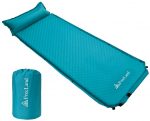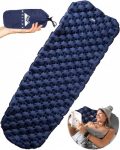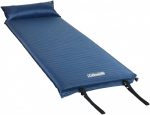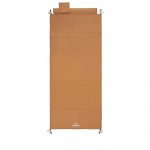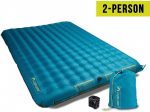The sleeping pad is one of the camping essentials you don’t want to skip.
The sleeping pad needs to be warm, comfy, and lightweight to fulfill its purpose.
A good sleeping pad can help you stay warm in the wild and get a good night of sleep, so you can continue with your outdoor activities well-rested.
A sleeping pad can be hard to choose if you don’t have the option to try it.
Therefore, I carefully selected the best sleeping pads for camping to save you time and effort for research.
Let’s hop right to it!
Outdoorsman Lab Ultralight Sleeping Pad
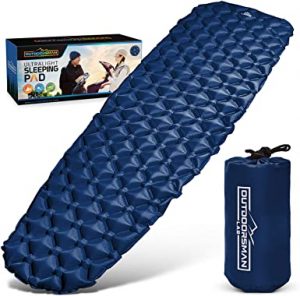
This Outdoorsman lab sleeping comfort provides excellent comfort whenever you sleep in the wild.
The pad is only two-inches thick and is very lightweight.
The inner individual air cells are interconnected to ensure maximum comfort.
The pad is also easy to inflate without mechanical assistance.
Pros
- Simple inflation
- Ultra lightweight
- Lifetime warranty
Cons
- Poor valve placement
 Dylan's Take
Dylan's TakeThe Outdoorsman lab sleeping pad is just what you need to get a full night of sleep when camping.
The pad includes a lifetime warranty, so you ask for a replacement when you notice problems with it.
Klymit Static V Lightweight Sleeping Pad
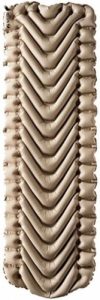
The Static V from Klymit is one of the lightest sleeping pads on the market.
It weighs around 18 ounces and has a skin-friendly, 75D polyester cover.
Also, because of the specific, V-chamber design, the pad limits air movements and retains heat.
It can pack as small as 3 x 8 inches, so it is perfect for backpackers and campers.
The pad comes with a stuff sack and a patch kit.
Pros
- Cozy
- Push valve is easy to use
- Lightweight
Cons
- The inflation is a bit unstable
 Dylan's Take
Dylan's TakeThe Klymit sleeping pad is available in three colors.
It is easy to pack, and you can rely on it to keep you warm during chilly nights outside.
Freeland Camping Sleeping Pad
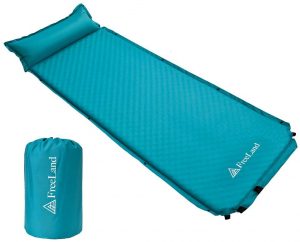
This Freeland sleeping pad features resistant, waterproof 190T polyester pongee construction.
The fabric has a tufted texture and is very resistant to tear and damage.
Also, it doesn’t weigh more than 4 pounds, which makes it perfect for carrying on all your trips.
The pad includes an attached pillow and free-flow valves.
Pros
- Smart design, pillow attached
- Easy to inflate and deflate without pump
- Compact when packed
Cons
- Inflation might not be perfectly consistent
 Dylan's Take
Dylan's TakeWith this sleeping pad, there is no need for a pump.
The Freeland sleeping pad is perfect if you love to sleep in the open sky.
WELLAX Ultralight Air Sleeping Pad
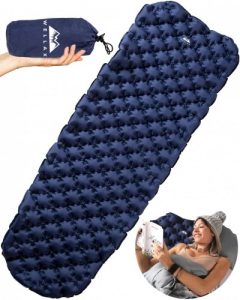
The Wellax sleeping mat uses 20D nylon with a TPU layer to ensure maximum comfort and reduce the weight of the mat.
The mat is also waterproof and resistant to abrasion and tear.
It features two flat valves that work interchangeably to ensure simple and quick inflation.
The Wellax mat is comfortable and suitable for use during three seasons, even in the late autumn.
Pros
- Lightweight
- Durable
- Easy to inflate
Cons
- Can lose air
 Dylan's Take
Dylan's TakeIf you purchase the Wellax sleeping mat, you are good to go for years.
It is a very durable and practical mat.
Therm-a-Rest Z Lite Sol

The Therm-a-Rest sleeping pad is easy to fold to a compact size, so it is an excellent choice for hikers, campers, and mountaineers.
The pad features ThermaCapture coating for excellent heat maintenance.
It improves the warmness by up to 20% to ensure a comfy experience while sleeping in the wild.
Also, users enjoy a soft foam structure on the middle of the pad and a denser structure on the bottom for better insulation and protection.
Pros
- Superior coating for better performance
- Lightweight
- Soft top layer
Cons
- Larger than most sleeping pads
 Dylan's Take
Dylan's TakeOverall, the Therm-a-Rest sleeping pad is comfortable and practical.
It has plenty of convenient features for all-season campers and is easy to maintain.
Coleman Self-Inflating Camping Pad
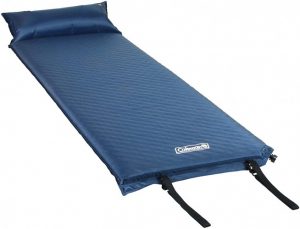
The Coleman camping pad has a soft design, which gives the user much-needed comfort.
The pad features a self-inflating design and has a free-flow valve.
Therefore, you don’t need a pump.
However, the pillow doesn’t have that valve, but it is easy to inflate and attach to the pad.
Pros
- Features compression straps for simple inflation
- Self-inflating
- Tear-resistant polyester shell
Cons
- Straps can loosen over the time
 Dylan's Take
Dylan's TakeWho doesn’t love soft structure while camping?
This Coleman pad is soft, durable, and comfortable, so all campers will be happy with it.
Teton Sports Outfitter Camping Pad
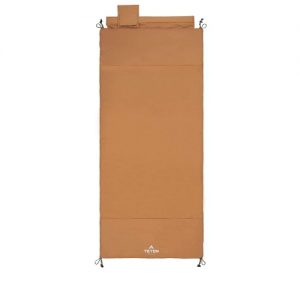
The Teton Outfitter camping pad provides the sleeping experience you can expect to get in your home bed.
The pad is thick and comfortable and can keep you warm during chilly nights in the early spring or autumn.
It is a multipurpose pad, suitable for a variety of uses – extra bed for guests, outdoor bed, or camping pad.
The Teton pad has an additional insulation layer for extra warmth.
Pros
- Perfect for camping
- Includes additional insulation layer
- Comfortable
Cons
- Light color gets dirty soon
 Dylan's Take
Dylan's TakeThe foam used for manufacturing this pad is similar to those used for mattresses.
It is also very durable, which is always an added plus.
ALPS Mountaineering Comfort Series Air Pad
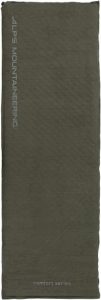
This sleeping pad by ALPS Mountaneering company is a best seller for solid reasons.
It ensures blissful rest due to soft polyester fabric with a suede effect.
The pad includes a jet stream wave foam which improves inflation and makes the pad compact and suitable for traveling.
Additionally, the pad has non-corrosive brass valves which last for years.
Pros
- Available in different sizes
- The fabric has anti-slip properties
- Brass valves are long-lasting
Cons
- Can be difficult to maintain
 Dylan's Take
Dylan's TakeThe ALPS Mounteering pad is a quality pad that is easy to roll, inflate and deflate.
It is practical for plenty of outdoor activities.
Lightspeed Outdoors 2 Person PVC-Free Air Bed
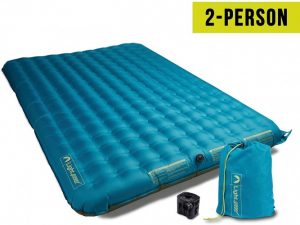
The Lightspeed sleeping pad is large enough to accommodate two people.
It also has an innovative Boston valve with a new stabilizer system which simplifies inflation and provides adjustable firmness.
The pad maintains a comfortable temperature and is quite comfortable.
Lightspeed pad features a battery-powered pump and weighs only six ounces.
Pros
- Firmness is adjustable
- Maintains the temperature well
- Resistant to abrasion
Cons
- Possible shipping issues
 Dylan's Take
Dylan's TakeIf you are looking for a large and cozy camping bed for you and your partner, the Lightspeed one might be perfect for you.
The pump is included, and the pad packs compact so it is easy to carry with you on your trips.
Buying Guide
The basic purpose of the sleeping pad is to give your comfort and enough warmness to sleep well when you sleep outside.
Sleeping pads are also used as protection against frostbites for campers who love camping in extremely cold weather.
There are several factors you need to consider when choosing a sleeping pad.
Let’s take a closer look.
Sleeping Pads Types
First of all, you need to know what you are buying.
Here is a short overview of the different types of sleeping pads.
Air Pads
Air pads are based on air to give you comfort.
These are suitable for backpackers who pack lightly and want to reduce the weight of their luggage.
Despite lack of the foam, these pads can be very comfortable.
Other benefits of an air pad are compact size when packed, and lightweight.
However, they can be more prone to damage than some other types and the inflation system might be inconvenient.
Self-Inflating Pads
These pads are similar to the previous types.
But, they feature an open-cell foam design to improve comfort and provide a stable surface for sleeping.
They are easier to inflate than air pods, but still, require the use of mouth as well.
However, these are heavier and can take time to deflate.
Closed-Cell Foam Pads
Lastly, closed-cell foam pads are the most affordable type on the market.
They are durable and extremely lightweight, but quite bulky when folded.
R-Value
The warmth is something many campers look for in their sleeping pads.
Most sleeping pads have an insulation layer between the ground and your back.
It also serves to maintain the warmth.
Generally, air pads and self-insulating pads have better insulation than closed-cell foam pads.
In general, R-value shows the amount of warmth the sleeping pad provides.
But, it can be hard to measure the warmth, so you should take the R-values assigned to each sleeping pad with care.
In general, an R-value of 5 and above means that the pad provides enough warmth to be used during cold winter nights.
R-value of 1 means that the pad doesn’t have insulation properties at all.
Thickness
The average thickness of a sleeping pad is between one and three inches.
The thicker the pad is, the higher above the ground it is.
Therefore, thicker pads are more comfortable and warmer.
Frequently Asked Questions About Sleeping Pads
Let’s answer the most common questions about sleeping pads.
Is a Sleeping Pad Necessary for Backpackers?
If you want to sleep well and warm, you need to get a sleeping pad.
It provides a comfortable bed for outdoor sleeping and keeps you warm during the nights.
Are Sleeping Pads Worth It?
When buying a sleeping pad, consider giving money on well-cushions and excellent insulation.
Additionally, check the fabric and durability of the pad.
Good quality pads can last for years and won’t lose their insulation properties.
Can you Use a Yoga Mat Instead of Sleeping Pad?
Yoga mats are for yoga exercises and not for camping.
They don’t have insulation layers and almost no cushioning at all.
However, if you own a thick yoga mat, it might serve as a sleeping pad during warm summer nights.
Conclusion
Experienced campers and backpackers prefer air pads.
They are easy to compress, lightweight, and provides solid insulation and comfort.
However, if the idea of blowing your bed with your mouth doesn’t seem right, you can choose self-inflating pads.
Make sure to have more space for packing because these take more space.
Best Overall Choice
Outdoorsman Lab Ultralight Sleeping Pad
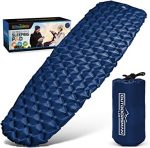
We're a team of professional travelers, on-the-go freelancers, web producers, writers and editors. Our mission is to pick the best travel gear by analyzing customer opinions and writing our own findings to help you find the right products for you. Please share our posts to help us grow. Read more...

